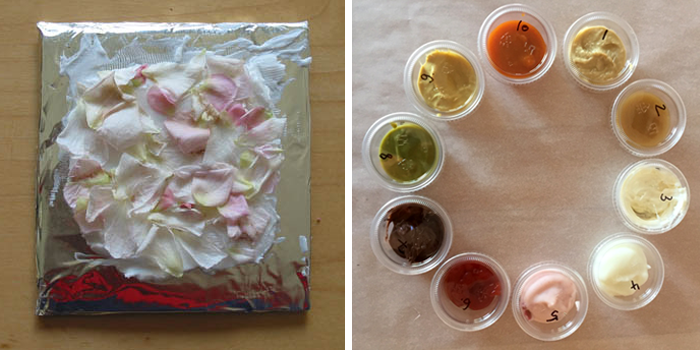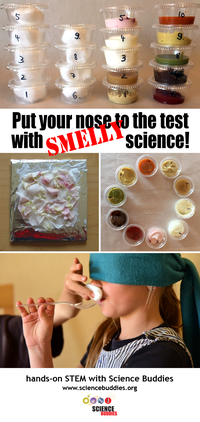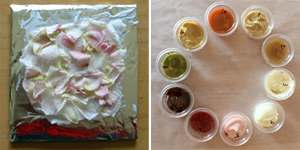Sniffing Out the Science of Smell
These science projects help students explore smell-based questions related to human biology and food science.

Sometimes, great science is right there at the tip of your nose. Like taste, how intensely or how accurately we smell things around us varies from person to person. You may even find that your sense of smell is stronger at certain times than others. Are you the first in your house to pick up the smell of a skunk in the area? Do you walk into the house and immediately smell if something has been cooking? Or are you someone who needs a lot of an odor before you really notice? What happens to your sense of smell when you are sick or have a stuffy nose?
Not everyone smells things quite the same or with the same odor threshold (the minimum amount of a smell it takes for you to "smell" it). With a sense like taste, there are things you can see on the tongue that can help you assess one's sense of taste. The differences in our sense of smell, however, cannot be easily quantified based on characteristics of the nose you can see and count. It doesn't matter if your nose is big or little, the olfactory equivalent to taste buds are tucked back in the nose, well out of sight!
Scientists used to generalize that humans could identify approximately 10,000 smells. They now say that the average human nose can tell the difference between approximately a trillion odors. While you may not be able to identify all those smells, your nose can pick up and differentiate between an amazing array of scents. Your nose is a very powerful and sensitive tool!
Getting hands-on with some smelly science invites students to put their noses (and the noses of friends and family members) to the test. With STEM projects related to the sense of smell, students can uncover ways in which taste and smell are related and even ways in which the science of smell plays an important role in the development of products like perfumes and foods.
Check these hands-on science projects for smelly science:
- Smelly Science: A Sniff Test: how much of a smell (or odorant) has to be in the air before the nose recognizes the smell? In this science project, survey a group of volunteers to determine the odorant threshold for different smells. This kind of testing plays an important role in product development and marketing!
- When Your Sniffer Snoozes, You've Got Olfactory Fatigue: even a scent that you identify quickly when exposed to a small whiff of it (like skunk) can become a scent that your brain doesn't register if you are over-exposed to the scent. Experiment to learn more about olfactory fatigue. Can you think of jobs in which this might happen? Are there situations in which olfactory fatigue might be harmful?
- Scintillating Scents: The Science of Making Perfume: put the science of smelling into practice by making your own perfume. In this science project, students use enfleurage to extract perfume oils from flowers and experiment to find out how much scent is needed to create a perfume.
- The Nose Knows Smell but How About Taste?: the tongue may hold thousands of specialized taste buds, but how much does your nose have to do with how something "tastes"? Maybe more than you think! When you are sick and temporarily "lose" your sense of smell, you might really notice how important smell is to how you respond to and interpret the world around you and even the food you eat.
- Battle of the Senses: Taste Versus Smell: How much does how something smells influence how it tastes? Can you change the way a food tastes by altering the way it smells?
Making Connections: Taste Bud Science
When it comes to taste buds, some people have so many that they are labeled supertasters. On the flip side, there are people with so few taste buds that they are referred to as non-tasters. In a fun hands-on science investigation, students can correlate the number of papillae on an individual's tongue with sense of taste.
Determining where you are on the scale between non-taster and supertaster is as easy as isolating a spot on the tongue and counting. See Taste Test: Do You have the Papillae of a Supertaster? for an inside look at this project.
Like the sense of smell, the sense of taste also involves thresholds. How much of a flavor does a food need before you taste it? See Taste Bud Science for a related student project and a family science activity.
Smell vs Taste
Have you ever noticed that a stuffy nose makes it harder for you to "taste" your food? The relationship between sense of taste and smell is fascinating.
A popular contest in television cooking competitions involves blindfolding contestants and seeing if they can identify ingredients based solely on smell. (A blind taste test is a variation on this challenge.) For a chef, smell is a very important part of food preparation. Can you sniff out the ingredients in a food (or spice) that is put in front of you if you don't see the food? Can you identify an ingredient by smell alone if you don't see or taste it?
You can put smell and taste to a hands-on test with the new Battle of the Senses: Taste Versus Smell food science project. Can you make an apple taste like a banana by altering the smell? Put it to a fun sensory science test!
Pin this collection:

Categories:
You Might Also Enjoy These Related Posts:
- 25+ Earth Day Science Experiments and Activities
- Arduino Science Projects and Physical Computing
- Spring Science Projects: 26 Science Experiments for Spring
- 25+ Robotics Projects, Lessons, and Activities
- March Madness Basketball Science Projects: Sports Science Experiments
- 15 Density Science Experiments
- 6 Picks for St. Patrick's Day STEM
- Mario Day STEM — Bring Mario World to Life with Hands-on Science and Engineering Activities!










